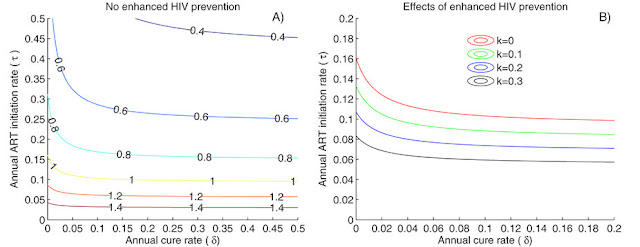HIV curative strategies
currently under development aim to eradicate latent provirus, or prevent viral
replication, progression to AIDS, and transmission. The impact of implementing
curative programs on HIV epidemics has not been considered.
We developed a mathematical
model of heterosexual HIV transmission to evaluate the independent and
synergistic impact of ART, HIV prevention interventions and cure on HIV
prevalence and incidence. The basic reproduction number was calculated to study
the potential for the epidemic to be eliminated. We explored scenarios with and
without the assumption that patients enrolled into HIV cure programs need to be
on antiretroviral treatment (ART).
In our simulations, curative regimes had
limited impact on HIV incidence if only ART patients were eligible for cure.
Cure implementation had a significant impact on HIV incidence if ART-untreated
patients were enrolled directly into cure programs. Concurrent HIV prevention
programs moderately decreased the percent of ART treated or cured patients
needed to achieve elimination.
We project that widespread implementation of HIV
cure would decrease HIV prevalence under all scenarios but would only lower
rate of new infections if ART-untreated patients were targeted. Current efforts
to identify untreated HIV patients will gain even further relevance upon
availability of an HIV cure.
Below: ART and HIV prevention coverage drive decreases in epidemic potential if only ART treated patients are eligible for cure interventions
Full article at:
By:
- 1Vaccine and Infectious Disease Division, Fred Hutchinson Cancer Research Center, Seattle, Washington, USA.
- 2Department of Applied Mathematics, University of Washington, Seattle, Washington, USA.
- 3Clinical Research Division, Fred Hutchinson Cancer Research Center, Seattle, Washington, USA.
- 4Department of Medicine, University of Washington, Seattle, Washington, USA.
- 5Department of Laboratory Medicine, University of Washington, Seattle, Washington, USA.
- Sci Rep. 2016 Feb 24;6:22183. doi: 10.1038/srep22183.
More at: https://twitter.com/hiv insight

No comments:
Post a Comment